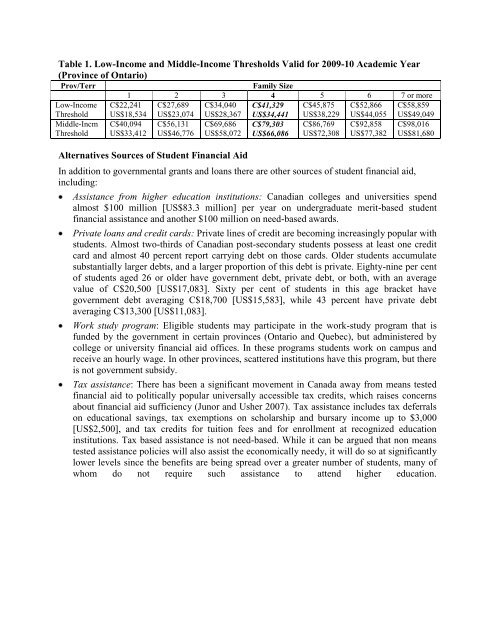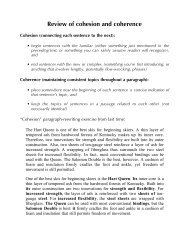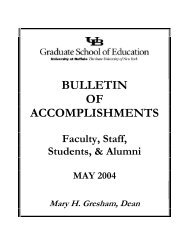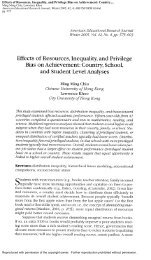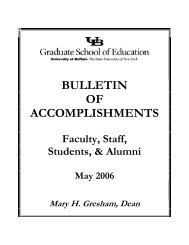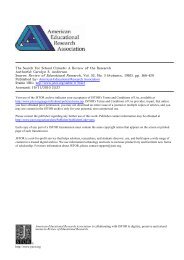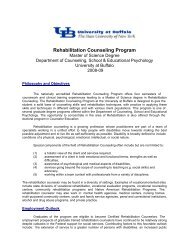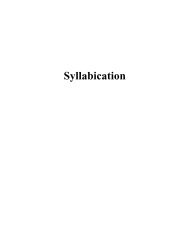Higher Education Finance and Cost-Sharing in Canada
Higher Education Finance and Cost-Sharing in Canada
Higher Education Finance and Cost-Sharing in Canada
Create successful ePaper yourself
Turn your PDF publications into a flip-book with our unique Google optimized e-Paper software.
Table 1. Low-Income <strong>and</strong> Middle-Income Thresholds Valid for 2009-10 Academic Year(Prov<strong>in</strong>ce of Ontario)Prov/TerrLow-IncomeThresholdMiddle-IncmThresholdFamily Size1 2 3 4 5 6 7 or moreC$22,241 C$27,689 C$34,040 C$41,329 C$45,875 C$52,866 C$58,859US$18,534 US$23,074 US$28,367 US$34,441 US$38,229 US$44,055 US$49,049C$40,094 C$56,131 C$69,686 C$79,303 C$86,769 C$92,858 C$98,016US$33,412 US$46,776 US$58,072 US$66,086 US$72,308 US$77,382 US$81,680Alternatives Sources of Student F<strong>in</strong>ancial AidIn addition to governmental grants <strong>and</strong> loans there are other sources of student f<strong>in</strong>ancial aid,<strong>in</strong>clud<strong>in</strong>g:Assistance from higher education <strong>in</strong>stitutions: Canadian colleges <strong>and</strong> universities spendalmost $100 million [US$83.3 million] per year on undergraduate merit-based studentf<strong>in</strong>ancial assistance <strong>and</strong> another $100 million on need-based awards.Private loans <strong>and</strong> credit cards: Private l<strong>in</strong>es of credit are becom<strong>in</strong>g <strong>in</strong>creas<strong>in</strong>gly popular withstudents. Almost two-thirds of Canadian post-secondary students possess at least one creditcard <strong>and</strong> almost 40 percent report carry<strong>in</strong>g debt on those cards. Older students accumulatesubstantially larger debts, <strong>and</strong> a larger proportion of this debt is private. Eighty-n<strong>in</strong>e per centof students aged 26 or older have government debt, private debt, or both, with an averagevalue of C$20,500 [US$17,083]. Sixty per cent of students <strong>in</strong> this age bracket havegovernment debt averag<strong>in</strong>g C$18,700 [US$15,583], while 43 percent have private debtaverag<strong>in</strong>g C$13,300 [US$11,083].Work study program: Eligible students may participate <strong>in</strong> the work-study program that isfunded by the government <strong>in</strong> certa<strong>in</strong> prov<strong>in</strong>ces (Ontario <strong>and</strong> Quebec), but adm<strong>in</strong>istered bycollege or university f<strong>in</strong>ancial aid offices. In these programs students work on campus <strong>and</strong>receive an hourly wage. In other prov<strong>in</strong>ces, scattered <strong>in</strong>stitutions have this program, but thereis not government subsidy.Tax assistance: There has been a significant movement <strong>in</strong> <strong>Canada</strong> away from means testedf<strong>in</strong>ancial aid to politically popular universally accessible tax credits, which raises concernsabout f<strong>in</strong>ancial aid sufficiency (Junor <strong>and</strong> Usher 2007). Tax assistance <strong>in</strong>cludes tax deferralson educational sav<strong>in</strong>gs, tax exemptions on scholarship <strong>and</strong> bursary <strong>in</strong>come up to $3,000[US$2,500], <strong>and</strong> tax credits for tuition fees <strong>and</strong> for enrollment at recognized education<strong>in</strong>stitutions. Tax based assistance is not need-based. While it can be argued that non meanstested assistance policies will also assist the economically needy, it will do so at significantlylower levels s<strong>in</strong>ce the benefits are be<strong>in</strong>g spread over a greater number of students, many ofwhom do not require such assistance to attend higher education.


